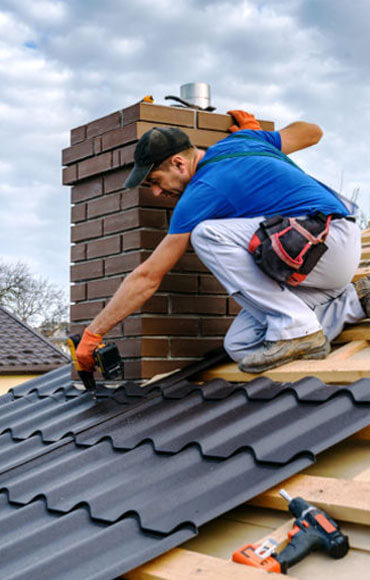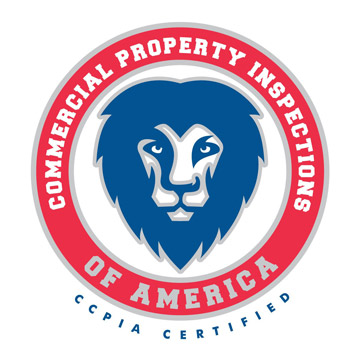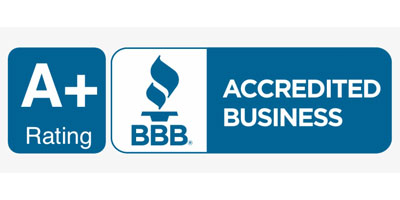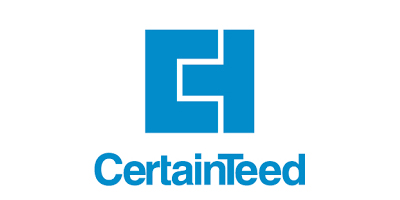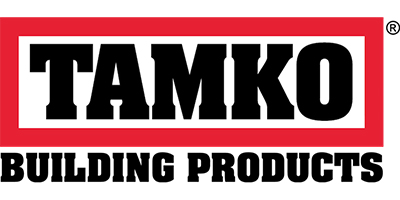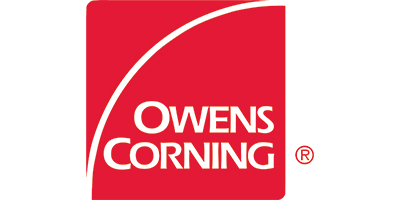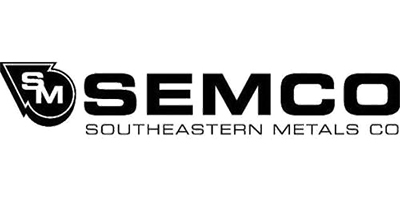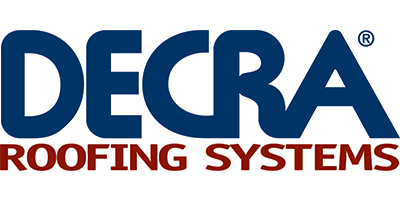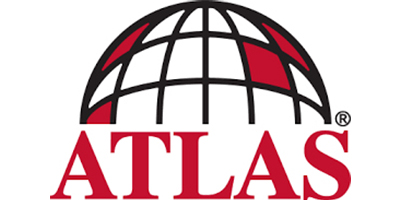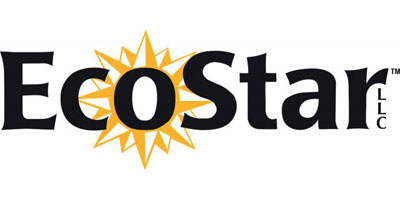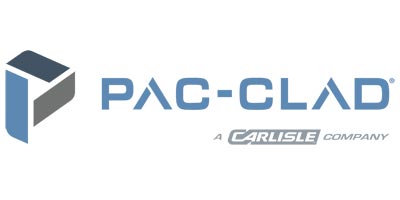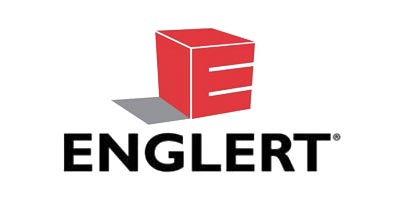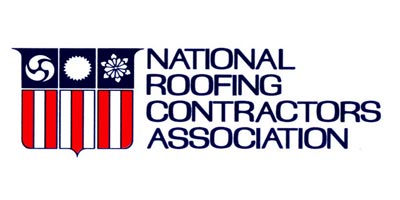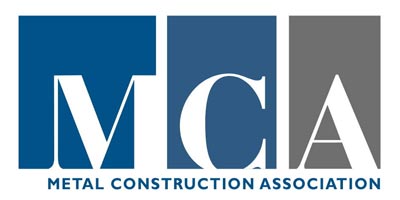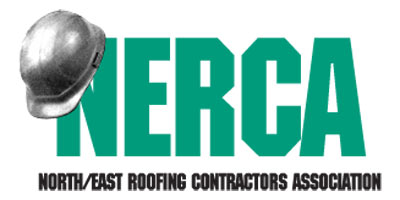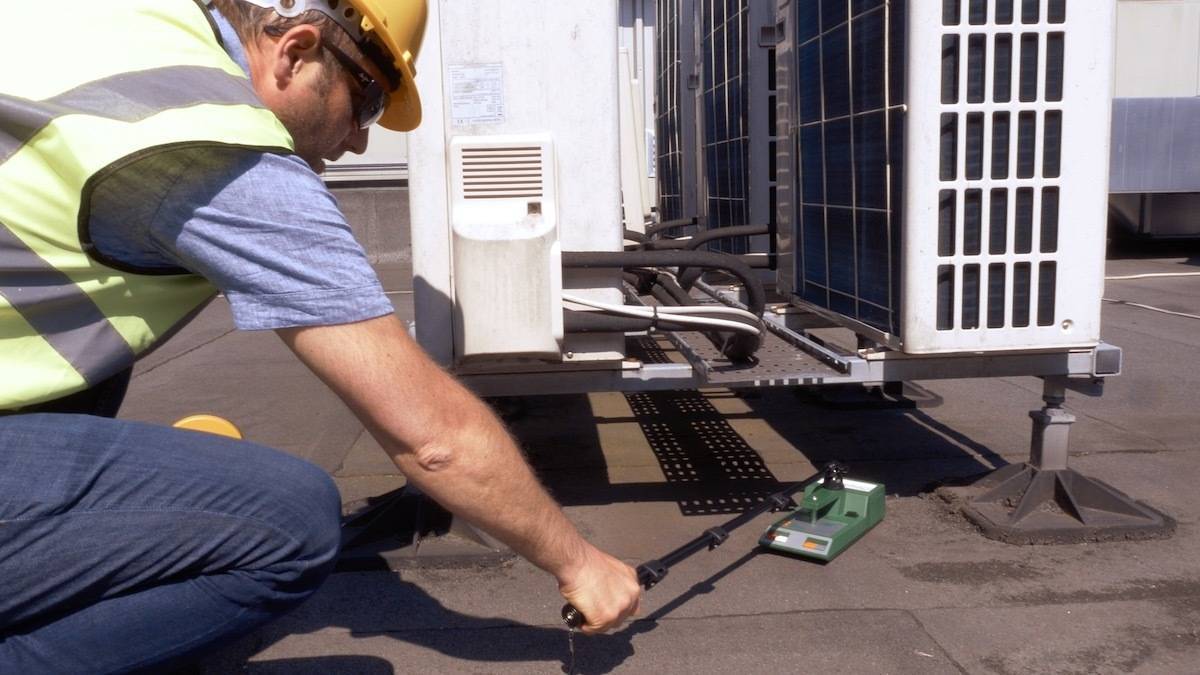
Commercial Roof Repair in Washington DC
GoTech Roofing Commercial Division is the leading provider of high-quality commercial roof repair in Washington DC. With over 40 years of experience, our team of skilled experts is equipped to manage any commercial roofing project, whether it’s a minor repair or a complete roof replacement. We specialize in a wide range of commercial roofing systems, including flat roofs, metal roofs, asphalt shingle roofs, and more. Our comprehensive services include commercial roof repair, roof replacement, roof installation, and maintenance. If you need reliable and professional commercial roofing services in Washington DC, trust GoTech Roofing to deliver top-notch results. Contact us today to schedule your free commercial roof inspection and get started on your roofing project.

Roof Leaks

Punctures

Open Seams

Hail Damage

Ridging & Splitting

Shrinkage

Weathering

Blow Offs & Billowing
The #1 Provider of Quality Commercial Roof Repairs in Washington, DC
Commercial Roof Leak: A Comprehensive Guide to Prevention and Solutions

Table of Contents
- Understanding Commercial Roof Leaks
- Causes of Commercial Roof Leaks
- Identifying Signs of a Commercial Roof Leak
- Advanced Technologies for Leak Detection
- Immediate Actions When a Leak is Discovered
- Commercial Roof Inspection and Assessment
- Repairing Commercial Roof Leaks
- When to Consider Commercial Roof Replacement
- Preventive Measures to Avoid Future Commercial Roof Leaks
- Choosing a Reliable Commercial Roofing Contractor
- The Role of Insurance in Commercial Roof Leaks
- Impact of Commercial Roof Leaks on Business Operations
-
FAQs
- 1. How Often Should a Commercial Roof Be Inspected?
- 2. What is the Average Lifespan of a Commercial Roof?
- 3. Can Regular Maintenance Prevent All Leaks?
- 4. What Should I Do if My Roof is Leaking During a Storm?
- 5. How Do I Choose the Best Roofing Material for My Building?
- 5. How Do I Take Advantage of the NEW Section 179 Commercial Roof Deduction?

Understanding Commercial Roof Leaks
1. Definition of a Commercial Roof Leak
A commercial roof leak occurs when water penetrates the roofing system and enters the building's interior. This can lead to various forms of damage, including structural weakening, mold growth, and damage to interior finishes.
Types of Commercial Roofs
Understanding the type of roof your commercial building has is essential in identifying potential vulnerabilities and appropriate solutions.
- Flat Roofs: Common in commercial buildings due to their cost-effectiveness and ease of installation. However, they are prone to water pooling and require excellent drainage systems.
- Pitched Roofs: Less common in commercial settings but offer better water runoff. They are often used in smaller commercial buildings and can be covered with various materials such as metal, tile, or shingles.
- Green Roofs: These are increasingly popular for their environmental benefits and aesthetic appeal. They involve a layer of vegetation and can help with insulation and stormwater management but require careful maintenance to prevent leaks.
2. Top 5 Most Common Commercial Roofing Types
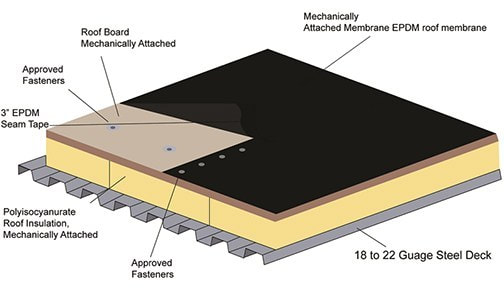
EPDM Roofing
EPDM consists of a large single-layered roll of durable synthetic black rubber roofing membrane. It is installed by applying an acrylic bonding agent. It used to be the cheapest of the flat roof options, but since COVID it has become much more expensive.But, there are several disadvantages of EPDM. First, it is black in color and its rubber surface tends to heat up in the sun. This can have a negative impact on the heating & cooling bill of the property owner. Second, because EPDM is made of black rubber, it tends to expand and contract as it heats from the summer sun and cools during the winter. This can lead to seams coming apart over the years. Thus, EPDM flat roof systems need regular inspection and maintenance to stay watertight. It now comes in highly reflective white color. But, the white color is approximately 40% more in cost per roll. In the past decade, TPO membranes have increasingly replaced EPDM, thanks to their longer lifespan and more cost-effective pricing.
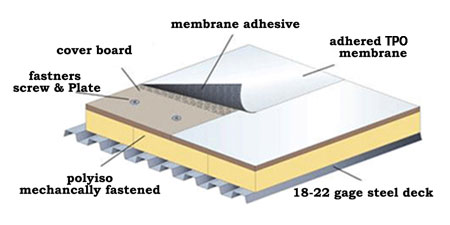
TPO Roofing
First introduced in the 1990s, TPO is a flat roofing solution that has become the most popular now. Recently, it has become less expensive than EPDM. TPO is made of a heat-reflective single-ply polypropylene membrane. One of the key advantages of TPO roofing is its durability. It is able to withstand extreme weather conditions, including hail, snow, and strong winds. This makes it an ideal choice for areas with extreme weather conditions. Another advantage of TPO roofing is its flexibility. TPO is a synthetic rubber material, which means it can stretch and move with the building as it expands and contracts with changes in temperature. This can help prevent cracking and other damage that can occur with other roofing materials. TPO roofing is also resistant to UV radiation, which can cause other roofing materials to break down over time. This type of flat roofing material is very lightweight and is laminated. The lamination keeps flat roof problems like algae or fungus from being able to grow on it. TPO is made of a white material. Many property owners like the white color as it reflects the Sun’s heat and helps in lowering the heating & cooling bill. TPO roofing is also relatively easy to install and maintain. It comes in large rolls that can be easily cut to fit the size and shape of the commercial roof. Once it is installed, TPO roofing requires little maintenance and can last for decades with only occasional inspections and repairs. TPO can be mechanically fastened or glued down with adhesive. TPO roofing lasts an average of 30 to 35 years.
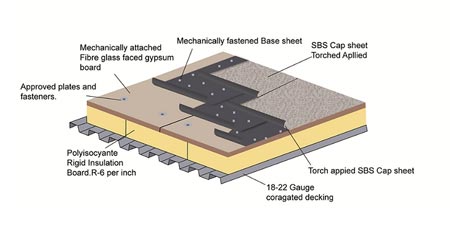
Modified Bitumen Roofing
One of the most popular commercial roofing systems in commercial roof projects is modified bitumen flat roof systems (MBS). To seal the roof, a modified bitumen system uses a special combination of coated basemat layers instead of applying a hot liquid adhesive to the uncoated basemat. A top layer is then installed on top of this. Modified bitumen flat roof systems have a reduced installation time when compared to a BUR flat roof systems. Another great advantage of a modified bitumen flat roof system is that you can install it on top of an older modified bitumen flat roof without taking off the old roof. Using this method, the flat roof actually becomes stronger and resists punctures due to the increased layers’ thickness. Not having to pay for the tear-off of the old modified bitumen flat roof systems is a huge cost-savings benefit. Modified Bitumen roofs typically last 15 to 20 years. Recently modified bitumen materials have gone up on price due to petroleum costs. It is actually about the same price as TPO membrane now, but TPO lasts 10 - 15 years longer.
There are two basic types of modified bitumen flat roof systems: 1) Torch-down and 2) Self-adhering:
Flat Roof Torch-Down Systems are installed with the help of specially designed substrates using a special combination of layers to torch-seal the bituminous product layers.
Self-Adhering Flat Roof Systems (SAS) are similar to conventional modified bitumen flat roof systems. The Self-adhering Flat Roof system uses a coated bitumen basemat to provide a waterproof seal on low-sloping and flat roofs. When a torch cannot be used, this product is ideal. Garage roofs or extending porches that intersect with wood or vinyl siding are common places where you will see a Self-Adhering Flat Roof system.
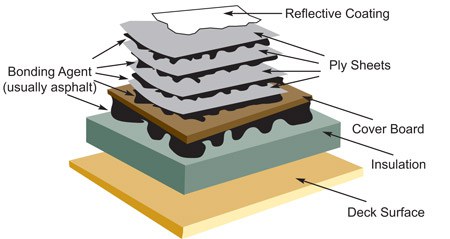
Built-Up Roofing
Built-Up Roofing has a long track record and has been used in the United States for over 100-years. Built-Up Roofing is often referred to as tar and gravel roofing. Unlike the single-ply roofing options that are so popular today, this type of roofing is created by alternating layers of bitumen and fabrics together to form a “membrane”. That membrane is then finished with an aggregate layer or coating. Typically, underneath a BUR Roof is a rigid insulation layer. After that, there are layers of felts, fabrics, or mats that are saturated with bitumen. The most common being asphalt (which works as a better fire retardant than the others). Other types include cold-applied adhesive or coal tar.
When the roofers are spreading a gooey black substance on their roofs with mops and mechanical spreaders, you probably have been watching them create built-up roofs. Built-up roof finishes often resemble rocky beaches because they contain gravel, slag, and small rocks mixed in with the asphalt. Built-up roofing systems have a variety of options, including mats that reinforce the ply sheets and types of bitumens used.
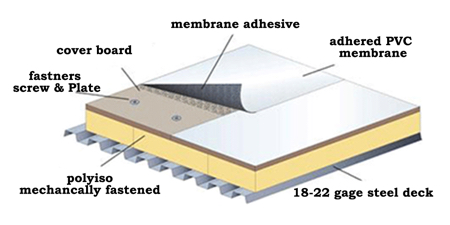
PVC Roofing
PVC has been around longer than TPO. Like TPO, PVC comes in lighter colors and is therefore highly reflective of the Sun’s heat. It is debated that TPO has a slightly better tear and break resistance and superior weathering than PVC. Having said that, PVC has characteristics that certain customers prefer and/or need. PVC has better chemical resistance than TPO. Oils and greases do not get absorbed into it which would lead to weakening the membrane. With PVC, the welded seams can be rewelded over the roof’s lifetime, and are stronger than the material itself. These characteristics make PVC the preferred flat roof membrane for restaurants and other commercial buildings that have grease traps on the roof. Finally, different from other roofing membranes, PVC trim from manufacturing is entirely recyclable. Post-consumer membranes can be returned and made into new membranes. Currently, PVC is about 40% more expensive than TPO membrane.
Causes of Commercial Roof Leaks
1. Poor Installation Practices
Improper installation can leave gaps, weak spots, and poorly sealed seams that allow water to penetrate the roof.
2. Weather-Related Damages
Severe weather conditions such as heavy rain, snow, hail, and high winds can cause significant damage to commercial roofs, leading to leaks.
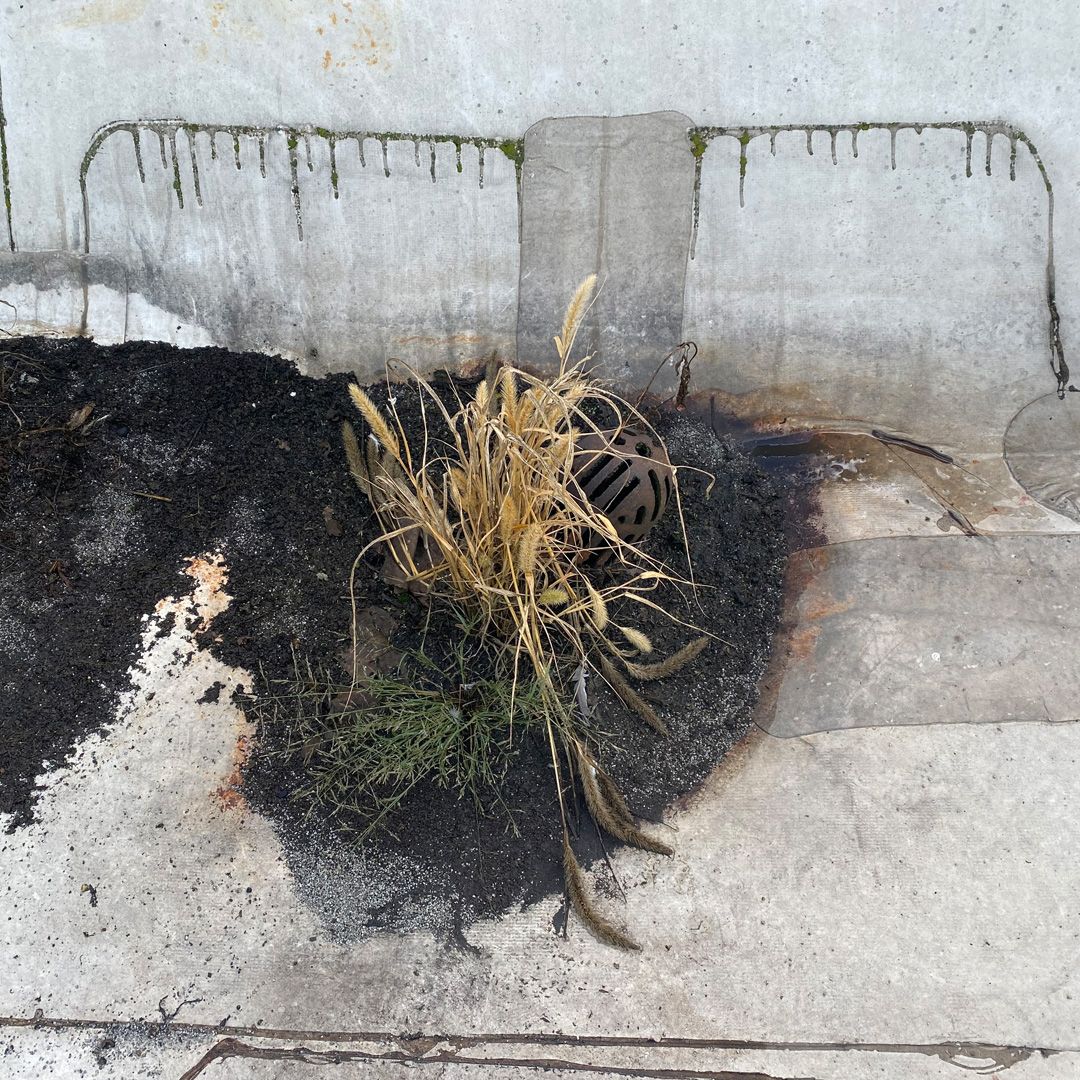
3. Lack of Maintenance
Neglecting regular maintenance can result in the accumulation of debris, clogged drains, and unnoticed minor damages that escalate over time.
4. Aging and Wear and Tear
Over time, roofing materials deteriorate due to exposure to the elements, leading to cracks, splits, and other forms of damage.
5. Roof Penetrations and Openings
Any penetration through the roof, such as HVAC installations, vents, and skylights, can become a potential leak point if not properly sealed.
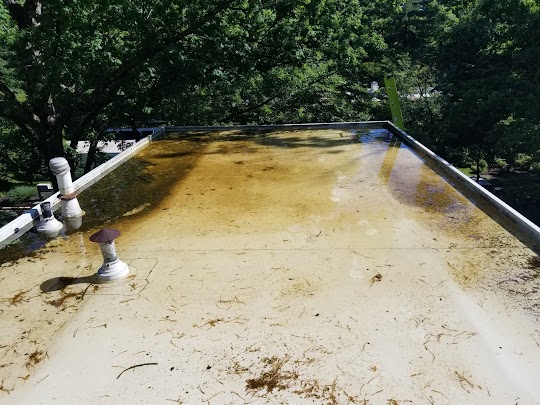
6. Ponding Water
Flat roofs are particularly susceptible to ponding water, which can degrade roofing materials and create a conducive environment for leaks.
7. Improper Roof Design
Design flaws such as insufficient slope, inadequate drainage, and poor material selection can contribute to the development of leaks.

Unlike steep sloped roofs, commercial flat roofs need a built-in drainage system to help remove rainwater and debris. Even though they are called flat roofs, there is always a little slope built in to the low-slope roof to drain water either to the edge gutters, or to roof drains. Inadequate or clogged drainage can lead to serious issues with a commercial flat roof, resulting in leaks - or a worse case, structural damage. Unfortunately, many commercial low-slope roofs are installed with improper slope. Check the following drainage components:
- Check for roof leaks.
- Check clogged roof drains, strainers, scuppers, and gutters.
- Check for obstructions to roof drains, scuppers, and gutters.
- Check for a missing or loose internal roof drain strainer.
- Check for active roof ponding and ponding stains.
- Check for dead-level roof.
- Check for lack of internal roof drain sumps or basins.
- Check for roof scupper and gutter metal deformities (freezing and thawing, ice damming, weathering, etc.).
- Check for past roof repairs.
Identifying Signs of a Commercial Roof Leak
1. Visible Water Stains on Ceilings and Walls
Water stains, often yellowish-brown, are a clear sign of a leak. They typically appear on ceilings and walls and can indicate the point of water entry.
2. Damp or Musty Odors
A persistent damp or musty smell in the building often suggests hidden moisture, which could be due to a roof leak.
3. Mold and Mildew Growth
Mold and mildew thrive in damp environments. Their presence indicates long-term moisture issues that need immediate attention.
4. Bubbling or Blistering of Roofing Material
Bubbles or blisters on the roofing material are signs of trapped moisture and can eventually lead to leaks.
5. Interior Damage such as Peeling Paint or Sagging Ceilings
Interior damage like peeling paint, sagging ceilings, and warped walls are indicators of water infiltration from a roof leak.
6. Increased Energy Bills
Unexplained increases in energy bills can be a result of compromised insulation due to roof leaks, leading to higher heating and cooling costs.
Advanced Technologies for Leak Detection
1. Infrared Thermography
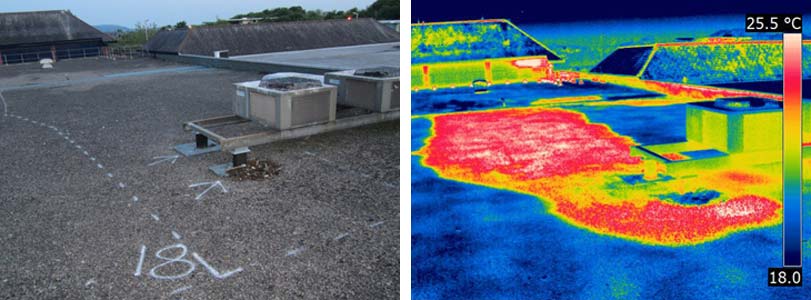
More effective and more efficient than any other commercial roof inspection procedure, infrared scanning (oftentimes called thermal imaging) by a certified commercial roof inspector detects moisture and identifies where it has penetrated into a roof system long before it breaks through and drips onto occupants below. The commercial roof inspector can use a handheld infrared / thermal imaging camera or infrared / thermal imaging drone. Typically the inspector will use an infrared / thermal imaging drone with very large commercial roofs because the drone will image moisture intrusion for the entire roof area at one time.
2. Electronic Leak Detection
Uses thermal imaging to detect temperature variations that indicate moisture presence.
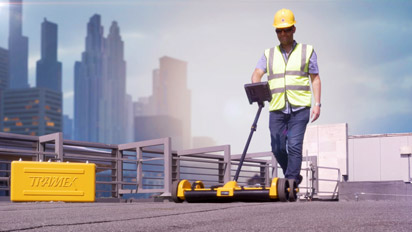

The Tramex Dec Scanner and Roof & Wall Scanner are designed to evaluate the moisture condition of an entire flat roof area to ASTM D7954 standards quickly & non-destructively. These precise instruments are used for detecting and tracing the source of a leak, as well as locating and moisture-mapping damaged PolyISO insulation and flat roofing membrane materials. These Tramex Roof Moisture Inspection Tools are not only for assessment of possible moisture problems, but can also be used to perform a water-tight integrity test on a newly installed roofing system.
3. Moisture Scanners
Measures moisture content in roofing materials to identify leak sources.

The Tramex CMEX5 moisture meter can check moisture content in PolyISO insulation with Tramex electrodes. In addition, it can measure ambient conditions in roof cavity spaces and structures using the Tramex relative humidity probes.
4. Benefits of Advanced Leak Detection Methods
These methods offer precise, non-invasive ways to detect leaks, reducing the need for extensive exploratory repairs.
Immediate Actions When a Leak is Discovered
1. Securing the Area
Immediately secure the affected area to prevent further damage to interior assets and ensure safety.
2. Temporary Leak Patching Solutions
Use temporary solutions such as tarps, sealants, or patch kits to control the leak until professional help arrives.
3. Contacting a Professional Roofer
Reach out to a professional roofing contractor to assess the situation and provide a permanent solution.
Commercial Roof Inspection and Assessment
1. Importance of Professional Inspection
Professional inspections are crucial for accurately identifying the source and extent of the leak, as well as determining the best repair strategy.
2. What to Expect During a Roof Inspection
During an inspection, expect the roofer to check for visible damage, test for moisture, inspect roofing materials, and assess drainage systems.
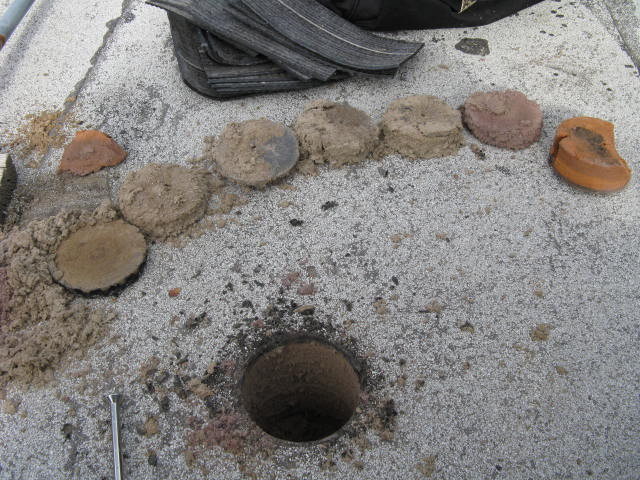
3. What is a Core Sample?
A core sample is when a commercial roofing inspector drills vertically down into the flat roof membrane with a special core cut tool to extract a core of all of the layers of the roof below the membrane down to the roof deck. Once the core is obtained the layers' results are documented and then the core sample is put back and the hole is repaired with a sealant.
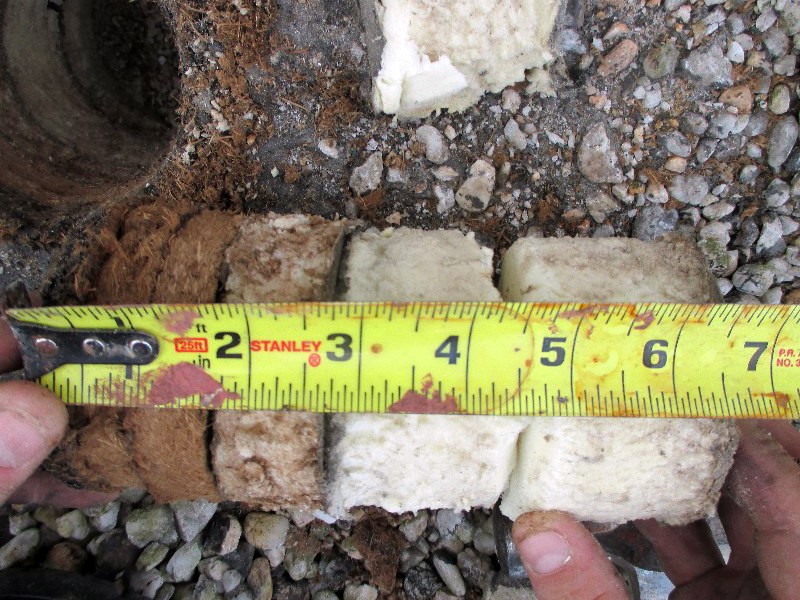
4. What Does a Core Sample Tell Us?
The core sample is visually inspected on the roof. But, if significant moisture is found below the roof membrane, then a sealed sample can be sent to a lab to document exactly what percentage of moisture has been found. This moisture evidence can be very crucial when an insurance claim has been filed. In addition to moisture, the core sample will tell the commercial roofing inspector the following facts:
- Layers – How many layers of roof assemblies are in place?
- Thickness – What is overall thickness of existing roof system?
- Composition – What are the layers of the existing roof system made of? What is the thickness of PolyISO insulation boards used. If there are 2 or more roofing assembly layers, what roofing membrane was used for the first roofing assembly layer? Can that first layer stay in place?
- Moisture – Is there water / moisture trapped below the top roofing membrane?
- Roof Deck – What material is the roof deck made from? Wood, metal, concrete?
- Slope – Is there structural slope built into the roof deck, or is the slope created from tapered PolyISO insulation boards?
- Hazardous Materials – Are there any hazardous materials (e.g. asbestos) in the commercial roof assembly that will require further testing?
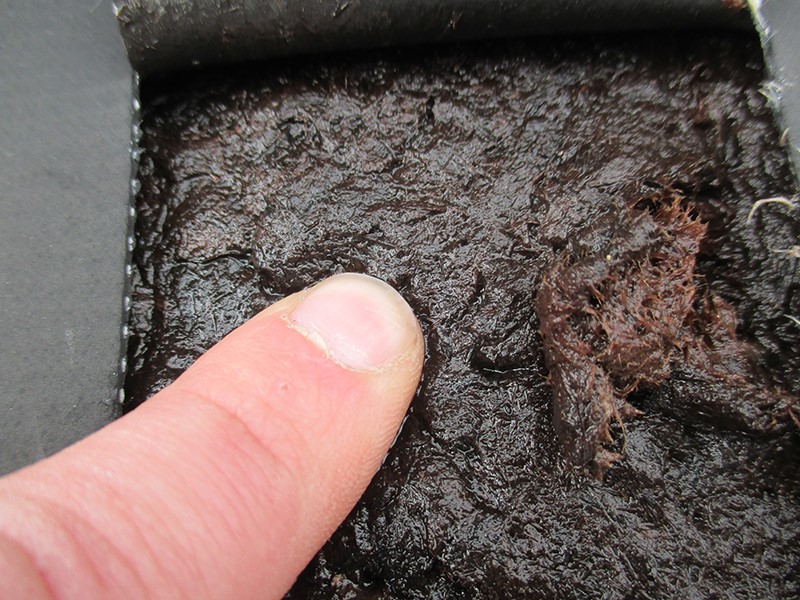
5. So Why Do These Core Sample Factors Matter?
These core sample factors matter as they will inform the Building Owner and Commercial Roofing Contractor what the current state of the existing roof system is, so that they can make an informed decision on what actions (if any) should be taken. Should the roof be repaired, restored, or completely replaced? Below are some of the factors that will affect this decision:
- Building Code – Core samples are the only way to determine how many roof layers there are. Typically, commercial buildings with 2 or more roof layers are required to have complete removal down to the roof deck per building code.
- Slope – Most flat roof membrane manufacturers and most building codes require positive drainage for the commercial roof system. Positive drainage can only be achieved by using a tapered PolyISO insulation board system and/or structural slope built into the roof deck assembly.
- Fastener Length – Fasteners used in a commercial roof assembly have to penetrate the roof deck by a specific measurement per manufacturer's specifications. Consequently, it is critical to determine the overall depth of the current roof assemblies in order to select the correct fastener screw length.
- Insulation R-Value Required – Core samples will show the overall R-Value of the current roof system. In some situations, the commercial building Owner may be required to upgrade the R-Value to meet building code.
- Deck Type – Typically the roof deck can be determined by through interior underdeck inspection. However, there are times when the seeing the underdeck is impossible, such as a permanent interior ceiling. It is critical to know the roof deck type as it affects the what method of roof attachment is to be chosen. Without knowing this critical roof deck factor, it is impossible to design the correct roof system.
- Slope – Is there structural slope built into the roof deck, or is the slope created from tapered PolyISO insulation boards?
- Hazardous Material Disposal – Are there any hazardous materials (e.g. asbestos) in the commercial roof assembly that will impact the removal and disposal process? Abestos removal can be quite expensive. This cost will have to be considered when pricing a commercial roof replacement.
6. Assessing the Extent of Damage
The inspection will help determine whether the damage is localized or widespread, influencing the repair or replacement decision.
7. Commercial Roof Inspection Report

It is important to stay informed about potential commercial roof problems so you can minimize future repair costs and increase the life expectancy of your roof system. The cost of weather-related roof emergencies is significant. Early roof problem detection reduces both stress and hassle, as well as the expense spent on commercial roof repairs or commercial roof replacements when bad storms strike. Moreover, the findings from a commercial roof inspection report will allow you to budget for future commercial roof expenses and an eventual commercial roof replacement.
After all of the commercial inspection steps listed in this article are completed, the commercial roof inspector will provide you with a detailed low slope roof inspection report (sometimes referred to as commercial roof survey). The report will provide the commercial building owner with a comprehensive evaluation of the low slope roof system, extensive photos of the roof, moisture meter findings report, infrared / thermal images of the roof and moisture mapping, and what next step actions are recommended.
Recommended actions to take may include repairing the commercial roof, restoring all (or part) of the commercial roof, or completely replacing the commercial roof system. You will want to consult with a reputable commercial roofing contractor to identify the potential roof solutions that will solve all existing roof deficiencies in the most economic way. A full commercial roof replacement is the costliest option and should only be recommended when the commercial roof is beyond repair or restoration. But, what roof factors determine when I should repair, restore, or replace? Please read the criteria below when making a decision:
Commercial Roof Repair, Roof Restore, or Roof Replace Decision Making Factors
- Repair – If your commercial roof inspection reveals that the majority of the roof is not saturated with moisture and there are only a few weak areas, minor roof repairs will be recommended. At GoTech Roofing we will always try to prolong the life of your existing commercial roof by performing roof repairs as a first option.
- Restore – If less than 25% of the commercial roof is saturated and the remainder of the commercial roof is nearing the end of its life, a commercial roof restoration will be the next option. Commercial roof restorations (for example silicone coating), can extend your existing commercial roof’s life by 10+ years and cost a fraction of a complete roof replacement. Visit our Commercial Roof Coatings page at: Commercial Roof Replacement
- Replace – Your roof may need to be replaced if the commercial roof inspection reveals more than 25% of the roof is saturated with moisture and there are multiple leaking areas on the roof’s surface. There comes a time in every commercial roof’s life when the roof is just too old and deteriorated, and attempting to repair it will be expensive. At this point, the roof repairs will typically only prolong full roof replacement for another 1-2 years. If the commercial roof is at this stage, it will be more cost effective to remove and replace the entire roof. Visit our roof replacement page at: Commercial Roof Replacement
How Much Does It Cost to Have Your Commercial Roof Inspected?
Depending on several factors Commercial Roof Inspection prices vary, such as how complex the roof system is, the size of the roof, and how much damage it has. The average cost of a commercial roof inspection is typically between $350 and $1,000. A reputable commercial roofing contractor will be able to provide you with a more precise quotation based on your unique roofing specifications.
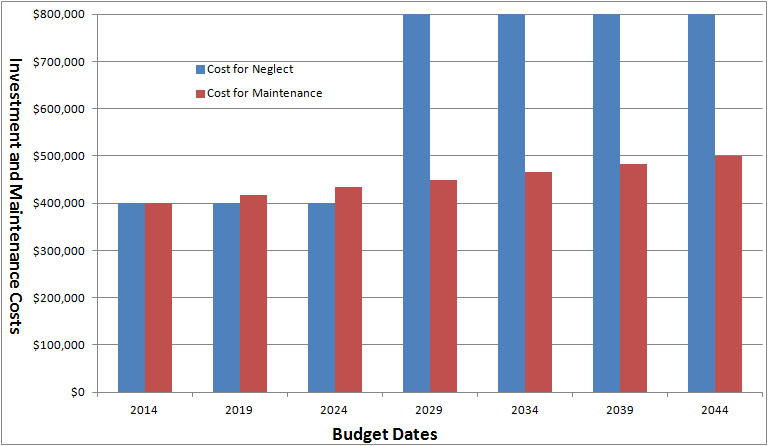
What Is The Cost If You Do Not Get Your Commercial Roof Inspected?
Commercial roofs are constantly under attack by UV radiation from the Sun, the endless cycle of being wet from weather and then drying out with heat, building structural movement, and other stresses. Normal aging will indeed occur on all commercial roofs. But, small roof problems stemming from neglect can result in costly repairs or worse, premature failure of the commercial roofing system. As you can see in the graph above, the cost for regular maintenance versus the cost for neglect is much cheaper over a 30-year span. A regularly scheduled program of both commercial roof inspections and roof maintenance will detect minor low slope roof problems before they become serious. This will, in turn, avoid costly tenant interruptions within the commercial building, and most importantly, protect the building Owner’s investment by adding years to the life of the roof.
The GoTech Roofing Team will provide you with a thorough commercial roof inspection. Contact us at (703) 417-9200 to get started today!
But, what should happen during a commercial roof inspection? Go to our commercial roof inspection page for a full explanation of what a professional commercial roof inspection should consist of: Commercial Roof Inspection
Repairing Commercial Roof Leaks
1. Common Repair Techniques
- Patching Small Flat Roof Leaks: Small leaks can often be repaired with membrane patches or elastomeric silicone roof sealants.
- Replacing Damaged Flat Roof Membrane Sections: More significant damage may require replacing entire sections of the roofing membrane material. If the leak is due to water ponding on the flat roof, the roofer will have to correct the roof slope so the flat roof has positive water drainage towards the nearest roof drain. This process is achieved by removing the wet rotten PolyISO insulation boards and replacing them with new tapered PolyISO insulation boards that create the needed slope. Then the roofer will have to replace the removed flat roofing membrane and reseal all seams.
2. Using Sealants and Coatings
Elastomeric Silicone Sealants and Coatings can provide a protective barrier, extending the life of the roof and preventing future leaks often at a fraction of the cost of a full roof replacement.
3. Cost of Repairs
Repair costs can vary depending on the extent of the damage, the materials required, and the labor involved. It's crucial to hire a contractor who specializes in commercial flat roof repairs, as many shingle roofers who only occasionally work on flat roofs lack the expertise and experience needed to properly handle these repairs.
When to Consider Roof Replacement
1. Factors Influencing Roof Replacement Decisions
Consider roof age, extent of damage, and overall condition when deciding between repair and replacement.
2. Benefits of Roof Replacement Over Repair
Replacing an old or extensively damaged roof can offer better protection, improved energy efficiency, longer-term savings, and peace of mind.
3. Choosing the Right Roofing Material for Replacement
Select materials based on durability, climate suitability, and budget. Consult with a professional commercial roofing contractor to make an informed decision.
4. Cost Considerations for Roof Replacement
Replacement costs include materials, labor, disposal of old roofing, and any additional roof deck structural repairs needed.
Preventive Measures to Avoid Future Leaks
1. Regular Maintenance Routines
Establish a routine for regular maintenance, including cleaning, minor repairs, and inspections.
2. Importance of Scheduled Inspections
Schedule professional inspections at least twice a year and after major weather events to catch issues early.
3. Proper Roof Cleaning Practices
Regularly remove debris, leaves, and other materials that can trap moisture and cause damage.
4. Ensuring Proper Drainage Systems
Maintain gutters, downspouts, and drainage systems to prevent water buildup and ponding on the roof.
5. Protective Coatings and Sealants
Apply coatings and sealants to add an extra layer of protection against the elements and potential leaks.
6. Training Maintenance Staff
Train your maintenance staff to recognize early signs of damage and perform basic repairs and upkeep.
Choosing a Reliable Roofing Contractor
1. Credentials to Look for in a Contractor
Ensure the contractor is licensed, insured, and has leading Manufacturer certifications and training, and is a member of relevant roofing associations.
2. Checking References and Reviews
Check reviews and ask for references to gauge the contractor's reliability and quality of work.
3. Importance of Experience and Specialization
Choose a commercial roofing contractor with experience and specialization in commercial roofing to ensure they understand the unique challenges and requirements.
4. Understanding Contractor Warranties
Understand the warranties offered on both materials and workmanship to protect your investment.
5. Getting Multiple Quotes
Obtain multiple quotes to compare pricing, services offered, and the overall value provided by different contractors.
GoTech Roofing is a trusted, manufacturer-certified contractor, fully trained and approved by the leading commercial roofing brands, including Firestone, Elevate, Carlisle, MuleHide, GAF, and GACO. Our certifications demonstrate our commitment to delivering top-quality commercial roof workmanship and adhering to the highest industry standards
The Role of Insurance in Commercial Roof Leaks
1. Understanding Commercial Property Insurance Policies
Review your policy to understand coverage limits, exclusions, and the process for filing claims related to roof leaks.
2. How to File a Claim for Roof Leak Damage
Document the damage, contact your insurance provider, and follow their guidelines for filing a claim.
3. Working with Insurance Adjusters
Be prepared to provide detailed information and documentation to the adjuster to support your claim.
4. Ensuring Proper Documentation
Keep detailed records of the roof damage, repairs made, and communication with your insurer to ensure a smooth claims process.
Impact of Commercial Roof Leaks on Business Operations
1. Disruption to Business Activities
Roof Leaks can lead to downtime, affecting productivity and customer service.
2. Financial Implications
Roof Repair costs, increased energy bills, and potential loss of inventory can have significant financial impacts.
3. Health and Safety Risks
Roof mold and structural damage pose health risks to employees and visitors, potentially leading to liability issues.
4. Legal Implications
Neglecting roof maintenance can lead to violations of building codes and regulations, resulting in fines and legal action.
Conclusion
Maintaining a commercial roof requires diligence, regular maintenance, and timely repairs. By understanding the causes of leaks, identifying signs early, and taking preventive measures, you can protect your investment and ensure the longevity of your commercial property.
FAQs
1. How Often Should a Commercial Roof Be Inspected?
Commercial roofs should be inspected at least twice a year and after any major weather events.
2. What is the Average Lifespan of a Commercial Roof?
The lifespan varies by material but generally ranges from 20 to 50 years.
3. Can Regular Maintenance Prevent All Leaks?
While regular maintenance can significantly reduce the risk of leaks, it cannot prevent all potential issues, especially those caused by severe weather or unforeseen events.
4. What Should I Do if My Roof is Leaking During a Storm?
Secure the area, use temporary measures to contain the leak, and contact a professional roofer as soon as possible.
5. How Do I Choose the Best Roofing Material for My Building?
Consider factors such as climate, building use, budget, and longevity when selecting roofing materials. Consulting with a professional roofer can help you make an informed decision.
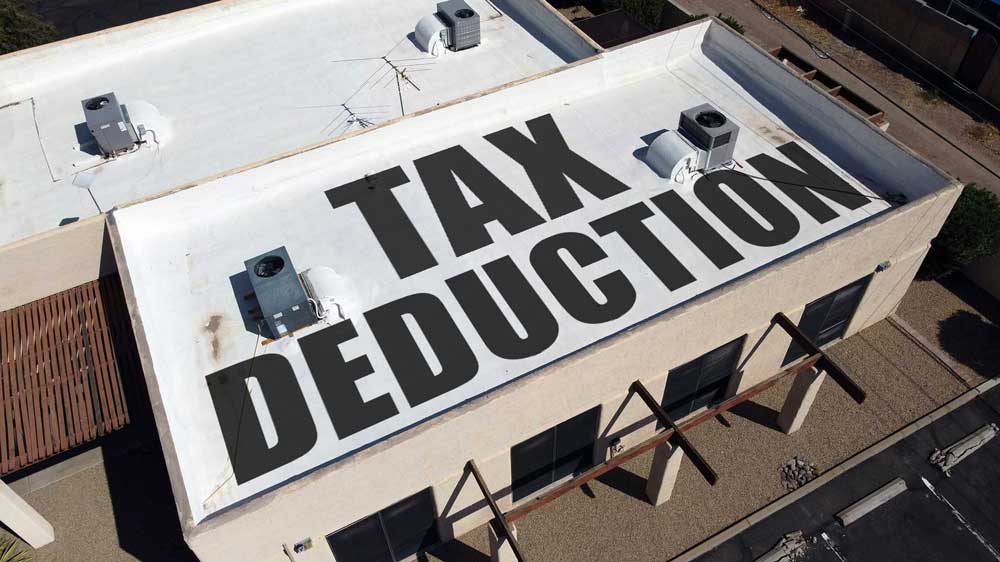
Take Advantage of the NEW Section 179 Commercial Roof Deduction
Section 179 allows businesses to deduct the full purchase price of qualifying roof repairs or roof replacement purchased or financed during the tax year. Understanding how this deduction works can help you make better financial decisions for your business.
Section 179 can only be used if you acquired your non-residential property by purchase for use in the active conduct of a trade or business or your rental activities qualify as a business for tax purposes. You can't use it if your rental activity is an investment, not a business. Owning rental property qualifies as a business if you do it to earn a profit and work at it regularly, systematically, and continuously—either by yourself or with the help of a manager, agent, or others. Rental ownership, on the other hand, is an investment, not a business, if you do it to earn a profit but don't work at it regularly, systematically, and continuously.
For detailed information on the NEW Section 179 Commercial Roof Deduction, please visit our page:
Understanding the Section 179 Deduction for a Commercial Roof: A Deep Dive

